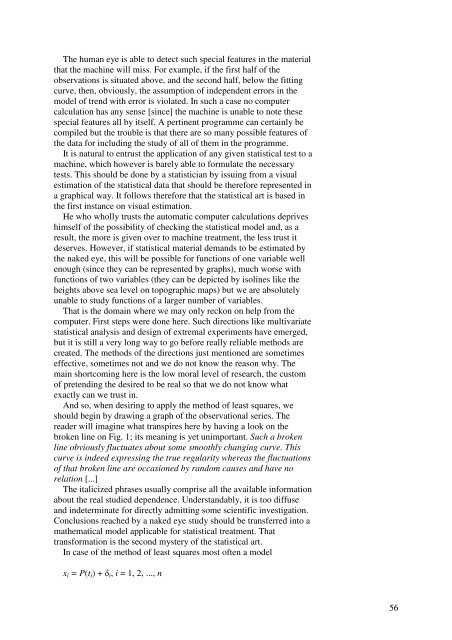1 Studies in the History of Statistics and Probability ... - Sheynin, Oscar
1 Studies in the History of Statistics and Probability ... - Sheynin, Oscar
1 Studies in the History of Statistics and Probability ... - Sheynin, Oscar
You also want an ePaper? Increase the reach of your titles
YUMPU automatically turns print PDFs into web optimized ePapers that Google loves.
The human eye is able to detect such special features <strong>in</strong> <strong>the</strong> materialthat <strong>the</strong> mach<strong>in</strong>e will miss. For example, if <strong>the</strong> first half <strong>of</strong> <strong>the</strong>observations is situated above, <strong>and</strong> <strong>the</strong> second half, below <strong>the</strong> fitt<strong>in</strong>gcurve, <strong>the</strong>n, obviously, <strong>the</strong> assumption <strong>of</strong> <strong>in</strong>dependent errors <strong>in</strong> <strong>the</strong>model <strong>of</strong> trend with error is violated. In such a case no computercalculation has any sense [s<strong>in</strong>ce] <strong>the</strong> mach<strong>in</strong>e is unable to note <strong>the</strong>sespecial features all by itself. A pert<strong>in</strong>ent programme can certa<strong>in</strong>ly becompiled but <strong>the</strong> trouble is that <strong>the</strong>re are so many possible features <strong>of</strong><strong>the</strong> data for <strong>in</strong>clud<strong>in</strong>g <strong>the</strong> study <strong>of</strong> all <strong>of</strong> <strong>the</strong>m <strong>in</strong> <strong>the</strong> programme.It is natural to entrust <strong>the</strong> application <strong>of</strong> any given statistical test to amach<strong>in</strong>e, which however is barely able to formulate <strong>the</strong> necessarytests. This should be done by a statistician by issu<strong>in</strong>g from a visualestimation <strong>of</strong> <strong>the</strong> statistical data that should be <strong>the</strong>refore represented <strong>in</strong>a graphical way. It follows <strong>the</strong>refore that <strong>the</strong> statistical art is based <strong>in</strong><strong>the</strong> first <strong>in</strong>stance on visual estimation.He who wholly trusts <strong>the</strong> automatic computer calculations depriveshimself <strong>of</strong> <strong>the</strong> possibility <strong>of</strong> check<strong>in</strong>g <strong>the</strong> statistical model <strong>and</strong>, as aresult, <strong>the</strong> more is given over to mach<strong>in</strong>e treatment, <strong>the</strong> less trust itdeserves. However, if statistical material dem<strong>and</strong>s to be estimated by<strong>the</strong> naked eye, this will be possible for functions <strong>of</strong> one variable wellenough (s<strong>in</strong>ce <strong>the</strong>y can be represented by graphs), much worse withfunctions <strong>of</strong> two variables (<strong>the</strong>y can be depicted by isol<strong>in</strong>es like <strong>the</strong>heights above sea level on topographic maps) but we are absolutelyunable to study functions <strong>of</strong> a larger number <strong>of</strong> variables.That is <strong>the</strong> doma<strong>in</strong> where we may only reckon on help from <strong>the</strong>computer. First steps were done here. Such directions like multivariatestatistical analysis <strong>and</strong> design <strong>of</strong> extremal experiments have emerged,but it is still a very long way to go before really reliable methods arecreated. The methods <strong>of</strong> <strong>the</strong> directions just mentioned are sometimeseffective, sometimes not <strong>and</strong> we do not know <strong>the</strong> reason why. Thema<strong>in</strong> shortcom<strong>in</strong>g here is <strong>the</strong> low moral level <strong>of</strong> research, <strong>the</strong> custom<strong>of</strong> pretend<strong>in</strong>g <strong>the</strong> desired to be real so that we do not know whatexactly can we trust <strong>in</strong>.And so, when desir<strong>in</strong>g to apply <strong>the</strong> method <strong>of</strong> least squares, weshould beg<strong>in</strong> by draw<strong>in</strong>g a graph <strong>of</strong> <strong>the</strong> observational series. Thereader will imag<strong>in</strong>e what transpires here by hav<strong>in</strong>g a look on <strong>the</strong>broken l<strong>in</strong>e on Fig. 1; its mean<strong>in</strong>g is yet unimportant. Such a brokenl<strong>in</strong>e obviously fluctuates about some smoothly chang<strong>in</strong>g curve. Thiscurve is <strong>in</strong>deed express<strong>in</strong>g <strong>the</strong> true regularity whereas <strong>the</strong> fluctuations<strong>of</strong> that broken l<strong>in</strong>e are occasioned by r<strong>and</strong>om causes <strong>and</strong> have norelation [...]The italicized phrases usually comprise all <strong>the</strong> available <strong>in</strong>formationabout <strong>the</strong> real studied dependence. Underst<strong>and</strong>ably, it is too diffuse<strong>and</strong> <strong>in</strong>determ<strong>in</strong>ate for directly admitt<strong>in</strong>g some scientific <strong>in</strong>vestigation.Conclusions reached by a naked eye study should be transferred <strong>in</strong>to ama<strong>the</strong>matical model applicable for statistical treatment. Thattransformation is <strong>the</strong> second mystery <strong>of</strong> <strong>the</strong> statistical art.In case <strong>of</strong> <strong>the</strong> method <strong>of</strong> least squares most <strong>of</strong>ten a modelx i = P(t i ) + δ i , i = 1, 2, ..., n56









